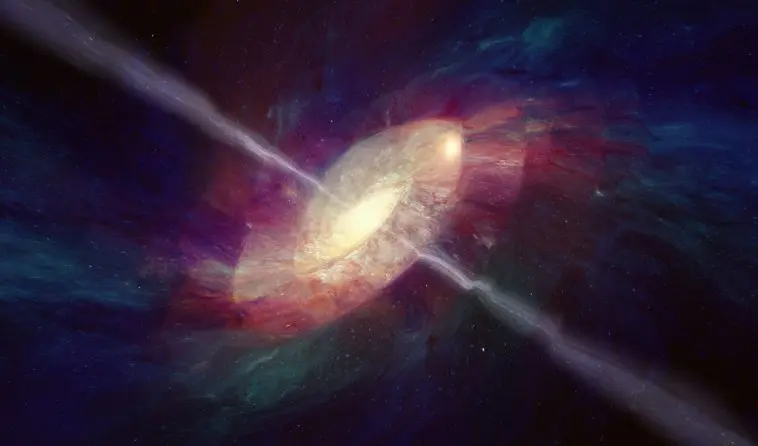[Originally published as Stellar Astronomy: Part 7 – Black Holes]
In the previous article, we examined white dwarfs and neutron stars, objects with the mass of a star compressed into a very small volume. Some of these objects could be what remains of a star that has collapsed in on itself. But what happens when mass is compressed into an even smaller volume?
White Dwarfs and Neutron Stars
In a white dwarf, atoms are as compressed as they can be. Hence, the mass of a star is compressed into a volume the size of earth due to the powerful force of gravity. Only the mutual repulsion of atomic electron shells prevents further collapse. But, if a white dwarf exceeds approximately 1.44 solar masses (the Chandrasekhar limit), the electrons are forced into the atomic nucleus, cancelling the positive charge of the protons, and forming a neutron star roughly the size of a small city. As fermions, neutrons cannot occupy the same quantum state (position and energy), so they are prevented from collapsing further.
However, gravity is not like the other fundamental forces (such as electromagnetism). Rather than pulling objects through space, gravity bends space itself. You can think of space like a river.
Boats on a river will tend to move downstream even when their engines are off because the river is moving and the boats are stationary relative to the moving water. Likewise, gravity causes space itself to fall inward, and particles in that space are simply swept along. In a neutron star, outward pressure from neutrons closer to the core presses outward against the infalling space, keeping the neutron star from further collapse.
But what would happen if the gravity were so strong that the “velocity” of space reaches the speed of light? Since no material can move through space faster than the speed of light, there is no force that could prevent the neutrons from collapsing continually into a single point of no size at their center: a singularity.
The River Model of Black Holes
For a given mass, the radius at which space falls inward at the speed of light is called the Schwarzschild radius. Any mass that is entirely inside its own Schwarzschild radius must collapse into a singularity. This is because space is falling inward faster than the speed of light, and it would require an infinite amount of energy to accelerate a mass to the speed of light to prevent collapse.1 In practice, this means that neutron stars have an upper mass limit of approximately three solar masses. Beyond that, they must collapse into a singularity.
Furthermore, any object that comes closer to the singularity than the Schwarzschild radius must also fall into the singularity and add to its mass. Think of the singularity as being surrounded by an invisible sphere with a radius of the Schwarzschild radius. This sphere of no return is called the event horizon. Anything that touches the sphere must be sucked in and add to the mass of the singularity. Thus, this sphere acts a bit like a hole in space into which objects can fall never to return. And since even light cannot escape this region, the hole will necessarily be black. Hence, this is a black hole.
Amazingly, all the mass of a black hole, which would be several times the mass of the sun, is located at its exact center — in the singularity. But this singularity is surrounded by an event horizon, an abstract sphere that represents the minimum distance an object can pass without necessarily being pulled into the singularity. There is nothing physical at the event horizon — it simply represents the threshold of the black hole.
How to Detect a Black Hole
The idea of black holes predates Einstein. In 1783, the British scientist John Michell first proposed the idea of a dark star — a star whose gravity is so strong that even light itself must fall back to the star, rendering the star invisible. But if they are invisible, how could such an object ever be discovered? Furthermore, the physics necessary to describe the workings of such an object would not be discovered until Einstein’s general theory of relativity in 1915. Nevertheless, Michell proposed a clever way to detect an invisible stellar-mass object.
Many stars are part of a binary system in which two or more stars orbit their common center of mass. If one of the masses is a black hole, then the star would seem to orbit around nothing. By measuring the orbital motion of the visible star, we can determine the mass of its unseen companion. Astronomers discovered a black hole by this method in 1972. By measuring its Doppler shift, astronomers found that the blue supergiant star HDE 226868 orbits an invisible companion every 5.6 days. From this, we can compute the mass of the invisible object at 21 solar masses. This is far too massive to be a white dwarf or neutron star, both of which emit visible light. As such, the object must be a black hole. The size of this black hole (the diameter of its event horizon) is only 77 miles.
This black hole and its companion star orbit so close to each other (0.2 AU) that the black hole apparently pulls gas away from the star’s surface. This gas spirals around the black hole, forming an accretion disk which gradually spirals into the event horizon. This process heats the inner disk to a temperature of millions of degrees. This produces powerful X-ray,s which have been detected on earth.
In fact, it was the X-ray emission that drew the attention of astronomers to this system in 1965. The phenomenon is called Cygnus X-1 because it was the first such X-ray source detected in the constellation Cygnus. It wasn’t until 1972, however, that the system was discovered to contain a black hole.
The Bending of Light
Although black holes themselves cannot be seen since they absorb all light that intersects the event horizon, they do affect the appearance of the universe beyond. So, if you were relatively close to a black hole, you could tell it was there. First, there would be a circular black spot apparently devoid of any stars or galaxies. And around this spot, the stars and background galaxies would appear to be distorted in arcs around the disk. This is because the intense gravitational field of the black hole bends the paths of any nearby light beams. In fact, any object with gravity bends the path of light. But for most objects, the bending is so slight as to be virtually undetectable.2
On the other hand, light passing close to the event horizon of a black hole is severely bent. Thus, black holes act like a strange magnifying glass, brightening and distorting the appearance of objects in the background. In some cases, light is bent so strongly that it loops entirely around the black hole. This effect can create multiple images of background objects at various distances from the event horizon. In fact, if you were orbiting sufficiently close to a black hole, using a telescope, you could see multiple images of your own ship. At a distance of 1.5 Schwarzschild radii, light can actually orbit a black hole.
Furthermore, a number of black holes orbit so close to a companion star that they form an accretion disk as in the Cygnus X-1 system. Thus, the black hole could be identified by a glowing ring of material surrounding a black disk. It is important to note that we have not (as yet) directly imaged the accretion disk around a stellar mass black hole like Cygnus X-1 because they are far too small for existing technology. However, we will see below that supermassive black hole accretion disks have now been directly imaged in radio.
Footnotes
- The speed of light is an upper limit on mass moving through space. Thus, mass cannot move through space faster than the speed of light. But space itself can be pulled by gravity at any speed — even faster than that light. This is what makes black holes possible.
- Nevertheless, in 1919, astronomers were able to measure the slight bending of light by the sun’s gravity seen in background stars during a total solar eclipse. The quantity of deflection matched the predictions of Einstein’s general theory of relativity.







